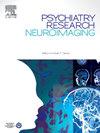Differential precuneus and frontal activity associated with facial emotion processing in adolescent depression
IF 2.1
4区 医学
Q3 CLINICAL NEUROLOGY
引用次数: 0
Abstract
Adolescence is a critical period of vulnerability to mental health issues, yet emotion processing in adolescent depression remains understudied. This task-based functional Magnetic Resonance Imaging (fMRI) study examines emotion processing in depressed adolescents and the effects of Cognitive Behavioural Therapy (CBT). fMRI data were collected during an emotional face processing task from 94 depressed adolescents and 34 healthy controls at baseline. As part of a feasibility study, a longitudinal sub-cohort of 14 depressed adolescents and 33 controls underwent follow-up scans after 24 weeks of CBT. Whole-brain analyses estimated: (a) neural responses to overall facial emotions, and (b) a dynamic range of responses to varying emotion intensities. At baseline, depressed adolescents exhibited greater precuneus activity for positive emotions and hypoactivity in the frontal pole for negative emotions, both correlating with trait anxiety. Although CBT did not significantly alter neural responses in the smaller follow-up sample, behavioural data indicated that depressed adolescents rated high-intensity sad faces as less sad post-treatment. These findings underscore the importance of early interventions targeting emotional biases in adolescent depression. Future studies with larger samples are needed to clarify neural mechanisms of treatment effects.
青少年抑郁症患者楔前叶和额叶活动差异与面部情绪加工相关
青春期是易受心理健康问题影响的关键时期,但青少年抑郁症的情绪处理仍未得到充分研究。这项基于任务的功能性磁共振成像(fMRI)研究探讨了抑郁青少年的情绪处理和认知行为疗法(CBT)的效果。在情绪面部处理任务中收集了94名抑郁青少年和34名健康对照者的fMRI数据。作为可行性研究的一部分,14名抑郁青少年和33名对照组的纵向亚队列在24周的CBT治疗后接受了随访扫描。全脑分析估计:(a)对整体面部情绪的神经反应,(b)对不同情绪强度的动态反应范围。在基线时,抑郁青少年表现出积极情绪的楔前叶活动更大,而消极情绪的额极活动更少,两者都与特质焦虑相关。尽管CBT在较小的随访样本中没有显著改变神经反应,但行为数据表明,抑郁的青少年认为高强度的悲伤面孔在治疗后不那么悲伤。这些发现强调了针对青少年抑郁症情绪偏见的早期干预的重要性。未来需要更大样本的研究来阐明治疗效果的神经机制。
本文章由计算机程序翻译,如有差异,请以英文原文为准。
求助全文
约1分钟内获得全文
求助全文
来源期刊
CiteScore
3.80
自引率
0.00%
发文量
86
审稿时长
22.5 weeks
期刊介绍:
The Neuroimaging section of Psychiatry Research publishes manuscripts on positron emission tomography, magnetic resonance imaging, computerized electroencephalographic topography, regional cerebral blood flow, computed tomography, magnetoencephalography, autoradiography, post-mortem regional analyses, and other imaging techniques. Reports concerning results in psychiatric disorders, dementias, and the effects of behaviorial tasks and pharmacological treatments are featured. We also invite manuscripts on the methods of obtaining images and computer processing of the images themselves. Selected case reports are also published.

 求助内容:
求助内容: 应助结果提醒方式:
应助结果提醒方式:


